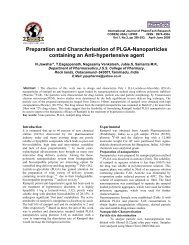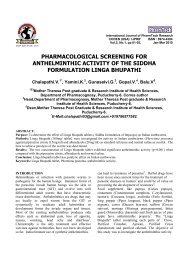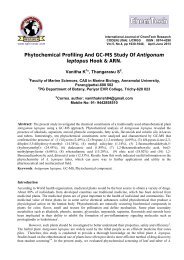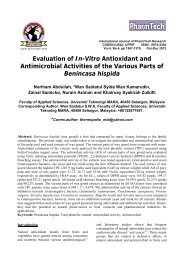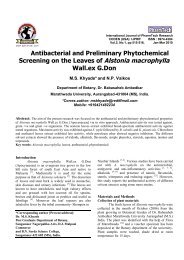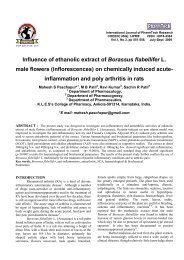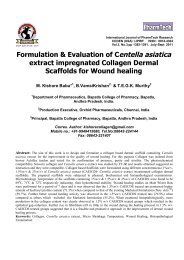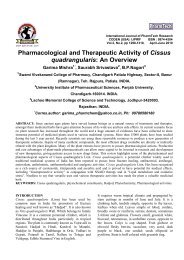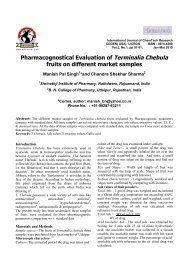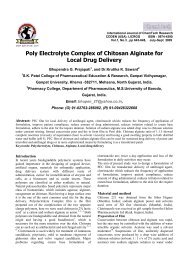HPTLC Method for determination of Terbinafine in the Bulk drug and ...
HPTLC Method for determination of Terbinafine in the Bulk drug and ...
HPTLC Method for determination of Terbinafine in the Bulk drug and ...
You also want an ePaper? Increase the reach of your titles
YUMPU automatically turns print PDFs into web optimized ePapers that Google loves.
Suma.B.V.et al /Int.J. ChemTech Res.2011,3(2) 743<br />
Stability test<strong>in</strong>g <strong>for</strong>ms an important part <strong>of</strong> <strong>the</strong> process<br />
<strong>of</strong> <strong>drug</strong> product development. The purpose <strong>of</strong> stability<br />
test<strong>in</strong>g is to provide evidence on how <strong>the</strong> quality <strong>of</strong> a<br />
<strong>drug</strong> substance or <strong>drug</strong> product varies with time under<br />
<strong>the</strong> <strong>in</strong>fluences <strong>of</strong> a variety <strong>of</strong> environmental factors<br />
such as temperature, humidity <strong>and</strong> light <strong>and</strong> enables<br />
recommendation <strong>of</strong> storage conditions, resets periods<br />
<strong>and</strong> shelf lives to be established. The two ma<strong>in</strong> aspects<br />
<strong>of</strong> <strong>drug</strong> products that play an important role <strong>in</strong> shelf<br />
life <strong>determ<strong>in</strong>ation</strong> are assay <strong>of</strong> active <strong>drug</strong> <strong>and</strong><br />
degradation products generated dur<strong>in</strong>g <strong>the</strong> stability<br />
study. 3 The assay <strong>of</strong> <strong>drug</strong> product <strong>in</strong> stability test<br />
sample needs to be determ<strong>in</strong>ed us<strong>in</strong>g stability<br />
<strong>in</strong>dicat<strong>in</strong>g method, as recommended by <strong>the</strong><br />
International Conference On Harmonization (ICH)<br />
guidel<strong>in</strong>e. 4 . The objective <strong>of</strong> this work was to develop<br />
a simple, precise <strong>and</strong> rapid <strong>HPTLC</strong> procedure which<br />
would serve as stability <strong>in</strong>dicat<strong>in</strong>g assay method <strong>for</strong><br />
<strong>Terb<strong>in</strong>af<strong>in</strong>e</strong> hydrochloride.<br />
<strong>Terb<strong>in</strong>af<strong>in</strong>e</strong> hydrochloride is <strong>of</strong>ficial <strong>in</strong> British<br />
pharmacopoeia 1 . The literature survey reveals that <strong>the</strong><br />
<strong>drug</strong> has been determ<strong>in</strong>ed <strong>in</strong> biological fluids (plasma,<br />
ur<strong>in</strong>e) tissues, nails <strong>and</strong> hair by HPLC 5,6,7,8,9,10,11,12 , <strong>in</strong><br />
13,<br />
tablets <strong>and</strong> creams by HPLC ,UV-<br />
Spectrophotometry, Spectrodensitometry, 14,15,16<br />
colorimetric method 17 , extraction Spectrophotometric<br />
method 18,19 , <strong>and</strong> Stability <strong>in</strong>dicat<strong>in</strong>g <strong>HPTLC</strong> 20<br />
This paper describes <strong>the</strong> <strong>for</strong>ced degradation <strong>of</strong><br />
<strong>drug</strong> under stress conditions that is <strong>the</strong>rmal, acid/base<br />
hydrolytic, photochemical, oxidative <strong>and</strong> stressed<br />
samples were analyzed by <strong>the</strong> proposed method. The<br />
method was validated as per ICH guide l<strong>in</strong>e <strong>for</strong><br />
l<strong>in</strong>earity, accuracy <strong>and</strong> precision 21<br />
Experimental data<br />
Chemicals <strong>and</strong> Reagents:<br />
<strong>Terb<strong>in</strong>af<strong>in</strong>e</strong> hydrochloride work<strong>in</strong>g st<strong>and</strong>ard was a<br />
generous gift from Novarits (India) Ltd, <strong>and</strong> was used.<br />
All <strong>the</strong> o<strong>the</strong>r reagents used were <strong>of</strong> analytical grade n-<br />
Hexane (AR grade), Acetone (AR grade), Acetic acid<br />
(AR grade) were purchased from Merck Ltd.<br />
Instrumentation:<br />
Chromatographic separation <strong>of</strong> <strong>drug</strong> was<br />
per<strong>for</strong>med on Merck TLC plates pre coated with silica<br />
gel 60F254 (10cmx10 cm) with 250 µm layer thickness<br />
from E Merck, Germany. The samples were applied on<br />
to plates as a b<strong>and</strong> with 5mm width with slit dimension<br />
<strong>of</strong> 6.00x0.3mm micro us<strong>in</strong>g Camag 100 µl sample<br />
syr<strong>in</strong>ge (Hamilton, Switzerl<strong>and</strong> ) with <strong>the</strong> L<strong>in</strong>omat 5<br />
applicator ( Camag Switzerl<strong>and</strong>) L<strong>in</strong>ear ascend<strong>in</strong>g<br />
development was carried out <strong>in</strong> a tw<strong>in</strong> through glass<br />
chamber (10 cm x 10cm) previously saturated with <strong>the</strong><br />
mobile phase at room temperature, us<strong>in</strong>g 30 m<strong>in</strong>utes <strong>of</strong><br />
chamber saturation .The development distance was<br />
approximately 90mm. Densitometry scann<strong>in</strong>g was<br />
,<br />
per<strong>for</strong>med us<strong>in</strong>g Camag TLC Scanner 3 <strong>in</strong> <strong>the</strong> range <strong>of</strong><br />
200-400nm <strong>and</strong> operated by W<strong>in</strong> cats s<strong>of</strong>tware (V1.43,<br />
Camag) us<strong>in</strong>g deuterium lamp as source <strong>of</strong> radiation.<br />
Selection <strong>of</strong> detection wavelength:<br />
<strong>Terb<strong>in</strong>af<strong>in</strong>e</strong> hydrochloride shows good absorbance at<br />
223nm .So it was selected as wave length <strong>of</strong> detection.<br />
<strong>Method</strong> development:<br />
Chromatographic separation <strong>of</strong> active <strong>and</strong> its degraded<br />
product was achieved us<strong>in</strong>g mobile phase <strong>of</strong> n hexane:<br />
acetone: glacial acetic acid <strong>in</strong> <strong>the</strong> ratio <strong>of</strong> 8:2:0.1v/v.<br />
St<strong>and</strong>ard <strong>and</strong> sample preparation:<br />
The st<strong>and</strong>ard stock solution 1mg/ml was prepared by<br />
dissolv<strong>in</strong>g work<strong>in</strong>g st<strong>and</strong>ard <strong>in</strong> methanol.<br />
For <strong>the</strong> preparation <strong>of</strong> sample solution, 20<br />
tablets were weighed <strong>in</strong>dividually; average weight was<br />
calculated <strong>and</strong> f<strong>in</strong>ally powdered. Appropriate portion<br />
<strong>of</strong> this powder equivalent to 50mg <strong>of</strong> <strong>Terb<strong>in</strong>af<strong>in</strong>e</strong><br />
hydrochloride was weighed <strong>and</strong> transferred to 50ml<br />
volumetric flask dissolved <strong>in</strong> little amount <strong>of</strong><br />
methanol, sonicated <strong>for</strong> 15 m<strong>in</strong>utes, filtered through<br />
Whatmann filter paper No.41, <strong>the</strong>n volume was made<br />
up to 50ml with methanol <strong>and</strong> <strong>the</strong> same concentration<br />
as per st<strong>and</strong>ard solution was used.<br />
Procedure <strong>for</strong> <strong>for</strong>ced degradation study <strong>of</strong> st<strong>and</strong>ard<br />
<strong>Terb<strong>in</strong>af<strong>in</strong>e</strong><br />
Forced degradation <strong>of</strong> <strong>drug</strong> product was carried out<br />
under <strong>the</strong>rmolytic, acid/base hydrolytic <strong>and</strong> oxidative<br />
stress condition. Thermal degradation <strong>of</strong> <strong>drug</strong> was<br />
carried out <strong>in</strong> solid state. After degradation stock<br />
solution were prepared by dissolv<strong>in</strong>g <strong>in</strong> methanol.<br />
From this solution aliquots were diluted with methanol<br />
to get concentration <strong>of</strong> (600ng) <strong>and</strong> spotted on <strong>the</strong> TLC<br />
plates <strong>in</strong> triplicate <strong>and</strong> chromatographed as described<br />
above<br />
Stress degradation <strong>of</strong> <strong>Terb<strong>in</strong>af<strong>in</strong>e</strong><br />
Degradation under base catalyzed hydrolytic<br />
condition:<br />
Accurately 25mg <strong>of</strong> st<strong>and</strong>ard <strong>drug</strong> was<br />
weighed <strong>and</strong> dissolved <strong>in</strong> 0.1 N methanolic sodium<br />
hydroxide <strong>in</strong> a 25 ml volumetric flask, refluxed <strong>for</strong><br />
6hrs at 60 o C from this 1 ml solution taken diluted to 10<br />
ml with methanol, 600ng/spot <strong>of</strong> sample was spotted at<br />
time <strong>in</strong>terval <strong>of</strong> 0, 1hr, 8hr, 12 hr <strong>and</strong> 24 hr, with a<br />
blank reagent <strong>and</strong> appropriately diluted st<strong>and</strong>ard<br />
solution spotted <strong>in</strong> adjo<strong>in</strong><strong>in</strong>g track.<br />
Degradation under acid catalyzed hydrolytic<br />
condition:<br />
Accurately 25mg <strong>of</strong> st<strong>and</strong>ard <strong>drug</strong> was<br />
weighed <strong>and</strong> dissolved <strong>in</strong> 1 N methanolic hydrochloric<br />
acid solution <strong>in</strong> a 25 ml volumetric flask, refluxed <strong>for</strong>



